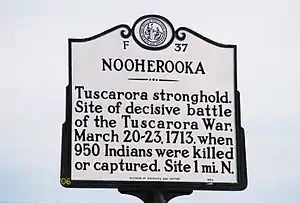Fort Neoheroka
Fort Neoheroka (or just Neoheroka, Neyuherú·kęʼ[2] in Tuscarora), or Nooherooka, is the name of a stronghold constructed in what is now Greene County, North Carolina by the Tuscarora tribe during the Tuscarora War of 1711–1715. In March 1713, the fort was besieged and ultimately attacked by a colonial force consisting of an army from the neighboring Province of South Carolina, under the command of Colonel James Moore and made up mainly of Indians including Yamasee, Apalachee, Catawba, and Cherokee. The 1713 siege lasted for more than three weeks, from around March 1 to March 22, 1713. Hundreds of men, women and children were burned to death in a fire that destroyed the fort. Approximately 170 more were killed outside the fort while approximately 400 were taken to South Carolina where they were sold into slavery. The defeat of the Tuscaroras, once the most powerful Indian tribe in the Province of North Carolina, opened up North Carolina's interior to further settlement. The supremacy of the Tuscaroras in the colony was broken forever, and most moved north to live among the Iroquois.[3][4][5] On July 17, 2009, the Fort Neoheroka Site was added to the National Register of Historic Places.[6]
Neoheroka Fort Site | |
 Fort Neoheroka historical marker near Snow Hill, North Carolina | |
  | |
| Nearest city | Snow Hill, North Carolina |
|---|---|
| Coordinates | 35°28′43″N 77°43′47″W |
| Area | 37 acres (15 ha) |
| Built | 1713 |
| NRHP reference No. | 09000529[1] |
| Added to NRHP | July 17, 2009 |
See also
References
| Library resources about Fort Neoheroka |
- "National Register Information System". National Register of Historic Places. National Park Service. July 9, 2010.
- Rudes, B. Tuscarora English Dictionary Toronto: University of Toronto Press, 1999
- Lee, Enoch Lawrence (1963). Indian Wars in North Carolina, 1663-1763 (1st ed.). Raleigh, North Carolina: Carolina Charter Tercentenary Commission. OCLC 477128.
- Whitford, Sara (2002). "Tuscarora put up fight to protect sacred site and ancestral remains at Fort Neoheroka". News From Indian Country. Retrieved August 2, 2009.
- "The Tuscarora War, 1711-1715". North Carolina Department of Cultural Resources: Office of Archives & History. North Carolina Historic Sites. April 21, 2009. Retrieved August 2, 2009.
- "Weekly List of Actions Taken on Properties: 7/20/09 through 7/24/09". National Register of Historic Places. National Park Service. July 31, 2009. Retrieved August 2, 2009.
External links
- Fort Neoheroka Excavation and Artifacts, tuscaroras.com
- Nooherooka 300th Commemoration, www.neyuheruke.org

